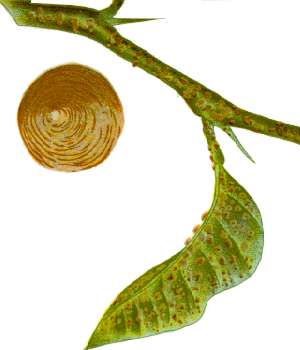Related Research Articles

Diaspididae is the largest family of scale insects with over 2650 described species in around 400 genera. As with all scale insects, the female produces a waxy protective scale beneath which it feeds on its host plant. Diaspidid scales are far more substantial than those of most other families, incorporating the exuviae from the first two nymphal instars and sometimes faecal matter and fragments of the host plant. These can be complex and extremely waterproof structures rather resembling a suit of armor. For this reason these insects are commonly referred to as armored scale insects. As it is so robust and firmly attached to the host plant, the scale often persists long after the insect has died.
Pseudo-arrhenotoky or paternal genome elimination is the phenomenon where males develop from fertilized eggs but the paternal genome is heterochromatinized or lost in the somatic cells and not passed on to their offspring.

Diaspidinae is the largest subfamily of Diaspididae, with 252 genera.

Aspidiotinae is a large subfamily of armored scale insects, with 193 genera.
Leucaspidini is a tribe of armored scale insects.
Odonaspidini is a tribe of armored scale insects.

Parlatoriini is a tribe of armored scale insects. Takagi (2002) indicated that the Parlatoriini appear to be phylogenetically related to the Smilacicola and the Odonaspidini. Takagi went on to say about the tropical east Asian Parlatoriini that, The current classification of their genera may be largely tentative because the adult females are simple-featured and much modified owing to the pupillarial mode of life, and also because the second instar nymphs are generally similar among parlatoriines, whether the adult females are pupillarial or not. Andersen found that separating out pupillarial forms into a separate subtribe, Gymnaspidina, was counterproductive, as being non-dispositive.
Thysanaspidini is a tribe of armored scale insects.
Aspidiellina is a subtribe of armored scale insects. While the subtribe Aspidiellina was not mentioned in Takagi's 2002 study, the Aspidiotini were not deemed as problematical as the Diaspidini and Lepidosaphidini.
Furcaspidina is a subtribe of armored scale insects, traditionally regarded as part of the Aspidiotini. While the subtribe Furcaspidina was not mentioned in Takagi's 2002 study, the Aspidiotini were not deemed as problematical as the Diaspidini and Lepidosaphidini. In 2006, Williams reduced the Furcaspidina to a single genus, with about twenty-eight species. Andersen in 2009 suggested that the Furcaspidina belonged in an expanded subfamily of Diaspidinae; however, additional analysis suggests that the furcaspids are better placed in a distinct, but laterally equivalent subfamily to the Diaspidinae, possibly together with the gymnaspids which Borchsenius placed in the Aspidiotinae subfamily.
Augulaspidina is a subtribe of armored scale insects. It was not confirmed by Takagi's 2002 study.

Chionaspidina is a subtribe of armored scale insects established by Borchenius. But unlike many of the subtribes recognized by Borchenius, this one was found to be morphologically valid by Takagi. Similarly, in molecular analysis, Andersen et al. found a clade roughly corresponding to the subtribe Chionaspidina.
Diaspidina is a subtribe of armored scale insects. It occurs mostly in the Americas and Africa, with a few species in tropical Asia. In the Americas Pseudoparlatoria is the largest genus, with Diaspis second; in Africa Diaspis is the largest genus. The grouping identified by Balachowsky in 1954 as the subtribe Diaspidina, are now the tribe Diaspidini.
Kuwanaspidina is a subtribe of armored scale insects. They feed on bamboo.
Rugaspidiotina is an obsolete subtribe of armored scale insects. It was established by Balachowsky in 1949 to accept those Diaspidinae which had rugaspidiotine characteristics as exemplified by genus Rugaspidiotus MacGillivray, species Rugaspidiotus arizonicus, and was moved from the Odonaspidini to the Diaspidini by Borchsenius. It was raised to tribe status as Rugaspidiotini. However, close examination of species assigned to the Rugaspidiotini showed that the rugaspidiotine characteristics convergently evolved in different groups of diaspidids. Rugaspidiotini and Rugaspidiotina are now regarded as obsolete groupings.
Sclopetaspidina is a subtribe of armored scale insects. It was not confirmed by Takagi's 2002 study.
Coccomytilina is a subtribe of armored scale insects.

Lepidosaphidina is a subtribe of armored scale insects.
Chionaspis is a genus of scale insect. In 2011 geographical sampling and analysis indicated a number of unnamed species in the genus Chionaspis.
Sadao Takagi is a Japanese entomologist who has specialised in the scale insects (Coccoidea), particularly the armoured scale insects of the Diaspididae.
References
- ↑ Borchsenius, N. S. (1966). Каталог щитовок (Диаспидоидеа) мировой фауны (A catalogue of the armoured scale insects (Diaspidoidea) of the world) (in Russian). Moscow: Академия наук СССР – Зоологический институт (Zoological Institute of the USSR Academy of Sciences). p. 204.
- ↑ Takagi, Sadao (2002). "One new subfamily and two new tribes of the Diaspididae (Homoptera: Coccoidea)" (PDF). Insecta Matsumurana. 59: 55–100. Archived from the original (PDF) on 28 December 2013. Retrieved 30 December 2013.
- ↑ Morse, Geoffrey E.; Normark, Benjamin B. (2006). "A molecular phylogenetic study of armoured scale insects (Hemiptera: Diaspididae)" (PDF). Systematic Entomology. 31 (2): 338–349, page 340. doi:10.1111/j.1365-3113.2005.00316.x.
- ↑ Andersen, Jeremy C.; et al. (2010). "A phylogenetic analysis of armored scale insects (Hemiptera: Diaspididae), based upon nuclear, mitochondrial, and endosymbiont gene sequences" (PDF). Molecular Phylogenetics & Evolution. 57 (3): 992–1003. doi:10.1016/j.ympev.2010.05.002. PMID 20460159. Archived from the original on 29 December 2013.